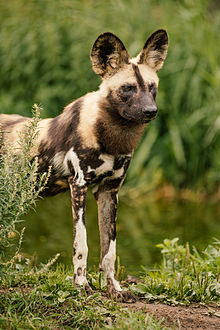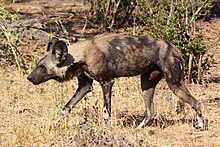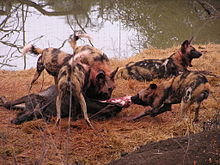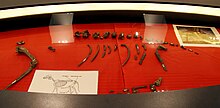
Anatomy and reproduction
See also: Canidae § Reproduction
The scientific name "Lycaon pictus" is derived from the Greek for "wolf" and the Latin for "painted". It is the only canid species to lack dewclaws on the forelimbs.This is the largest African dog canid and is the world's second largest extant wild canid, behind only the gray wolf,. Adults typically weigh 18–36 kilograms (40–79 lb).[2][3] A tall, lean animal, it stands about 75 cm (30 in) at the shoulder, with a head and body length of 75–141 cm (30–56 in) plus a tail of 30 to 45 cm (12 to 18 in). Animals in southern Africa are generally larger than those in eastern or western Africa.
Little sexual dimorphism is shown, though judging by skeletal dimensions, males are usually 3–7% larger. It has a dental formula of 3.1.4.23.1.4.3 for a total of 42 teeth. The premolars are relatively large compared with those of other canids, allowing it to consume a large quantity of bone, much like the hyena.[4] The heel of the lower carnassial M1 is crested with a single cusp, which enhances the shearing capacity of teeth and thus the speed at which prey can be consumed. This feature is called trenchant heel and is shared with two other canids: the Asian dhole and the South American bush dog.
The African wild dog may reproduce at any time of year, although mating peaks between March and June during the second half of the rainy season. The copulatory tie characteristic of mating in most canids has been reported to be absent[5] or very brief (less than one minute)[6] in the African wild dog, possibly an adaptation to the prevalence of larger predators in its environment.[7] Adult females possess 12 to 14 teats. [8] Litters can contain 2–19 pups, though ~10 is the most common.[9] The time between births is usually 12–14 months, though it can also be as short as six months if all of the previous young die. The typical gestation period is between 60 and 80 days.[10] Pups are usually born in dens dug and abandoned by other animals, such as the aardvark. Weaning takes place at about 10-11 weeks;[8] however, all-male packs without adult females have been recorded successfully raising pups from 5 weeks of age.[8] After three months, the pups leave the den and begin to run with the pack. At the age of eight to 11 months, they can kill small prey, but depend on the pack kills for most of their food. They do not become proficient hunters until the age of 12–14 months. Wild dogs reach sexual maturity at the age of 12–18 months.
Females will disperse from their birth pack at 14–30 months of age and join other packs that lack sexually mature females. Males typically do not leave the pack in which they were born. This is unusual among social mammals, among which the core pack tends to consist of related females. Among African wild dogs, females compete for access to males that will help rear their offspring. In a typical pack, males outnumber females by a factor of two to one, and only the dominant female can usually rear pups. This atypical situation may have evolved to ensure that packs do not overextend themselves by attempting to rear too many litters at the same time.[11] The species is also unusual in that some members of the pack, including males, may be left to guard the pups while the others, including the mothers, join the hunting group. The practice of leaving adults behind to guard the pups may decrease hunting efficiency in smaller packs.[12]
Social structure

Unrelated wild dogs sometimes join in packs, but this is usually temporary. Instead, unrelated wild dogs will occasionally attempt hostile takeovers of packs.[13]
Hunting and diet

Pack member at Samburu National Reserve

Dogs with a wildebeest carcass
After a successful hunt, the hunters will regurgitate meat for those that remained at the den during the hunt including the dominant female, the pups, the sick or injured, the old and infirm, and those that stayed back to guard the pups.

The wild dog's main prey varies among populations, but always centers around medium to large-sized ungulates, such as the impala, Thomson's gazelle, springbok, kudu, reedbuck, and wildebeest calves. The most frequent single prey species depends upon season and local availability. For example, in the Serengeti in the 1970s, wildebeest (mostly calves) were the most frequently taken species (57%) from January to June, but Thomson's gazelles were the most frequently taken (79%) during the rest of the year.[17] In the Selous Game Reserve, the most frequent prey is impala.[18] While the vast majority of its diet is made up of mammal prey, it sometimes hunts large birds, especially ostriches.[11] Other predators, such as lions, sometimes steal the prey that wild dogs catch.[19]
Some packs also include large animals among their prey, including zebras and warthogs; certain packs in the Serengeti specialized in hunting zebras in preference to other prey. [20] The frequency and success rates of hunting zebras and warthogs varies widely among specific packs. To hunt larger prey, wild dogs use a closely coordinated attack, beginning with a rapid charge to stampede the herd. One wild dog then grabs the victim's tail, while another attacks the upper lip or nose, and the remainder attempt to disembowel the animal. Male wild dogs usually perform the task of grabbing warthogs by the nose.[18] This behaviour is also used on other large, dangerous prey, such as the African buffalo, giraffe calves, and large antelope—even the one-ton giant eland.
Studies indicate this large-animal hunting tactic may be a learned behavior, passed on from generation to generation within specific hunting packs, rather than an instinctive behaviour.[citation needed] Some studies have also shown other information, such as the location of watering holes, may be passed on similarly.[citation needed]
Distribution and threats
The home range of packs varies depending on the size of the pack and the nature of the terrain. In the Serengeti, the average dog density (prior to the local extinction of the species) was one dog per 208 km2 (80 sq mi), whereas in the Selous Game Reserve, the average density was one dog every 25 km2 (9.7 sq mi). [18] However, the population density in the Serengeti as late as 1970 was as high as one dog per 35 km2 (14 sq mi) before falling to one in 200 km2 (77 sq mi) in 1977. [8] Their preferred habitat in the Serengeti is deciduous woodlands because of large prey herd size, lack of competition from other carnivores, and better sites for denning.[21] In the Serengeti, the average range has been estimated at 1,500 square kilometres (580 sq mi), although individual ranges overlap extensively.[11]Once, about 500,000 African wild dogs existed in 39 countries, and packs of 100 or more were not uncommon. This range once included Egypt and parts of the Sahara Desert.[22] Now, only about 3,000–5,500 are found in fewer than 25 countries,[1] or perhaps only 14 countries.[23] They are primarily found in eastern and southern Africa, mostly in the two remaining large populations associated with the Selous Game Reserve in Tanzania and the population centered in northern Botswana and eastern Namibia. Smaller but apparently secure populations of several hundred individuals are found in Zimbabwe (Hwange National Park),[24][25] South Africa (Kruger National Park), and in the Ruaha/Rungwa/Kisigo complex of Tanzania. Isolated populations persist in Zambia, Kenya, and Mozambique.
The African wild dog is an endangered species [26] due to habitat loss and poaching. It uses very large territories (so can persist only in large wildlife protected areas), and it is strongly affected by competition with larger carnivores that rely on the same prey base, particularly the lion and the spotted hyena. While the adult wild dogs can usually outrun the larger predators, lions often will kill as many wild dogs and cubs at the brooding site as they can, but do not eat them. One-to-one, the hyena is much more powerful than the wild dog, but a large group of wild dogs can successfully chase off a small number of hyenas because of their teamwork. It is also killed by livestock herders and game hunters, though it is typically no more (perhaps less) persecuted than other carnivores that pose more threat to livestock. Most of Africa's national parks are too small for a pack of wild dogs, so the packs expand to the unprotected areas, which tend to be ranch or farm land. Ranchers and farmers protect their domestic animals by killing the wild dogs. Like other carnivores, the African wild dog is sometimes affected by outbreaks of viral diseases such as rabies, distemper, and parvovirus. Although these diseases are not more pathogenic or virulent for wild dogs, the small size of most wild dog populations makes them vulnerable to local extinction due to diseases or other problems.[1]
Taxonomy
Lycaon pictus is the only extant species in the genus Lycaon. An extinct species from the African Pleistocene, Lycaon sekowei, is a possible ancestor of the modern species.[27] Another possible ancestor of these (and several other canids) from the Pleistocene of Eurasia is Xenocyon lycaonoides; this is sometimes also placed in Lycaon.[28] Although in a lineage distinct from wolves, domestic dogs, and coyotes, wild dogs are more closely related to them than to other canids.[29]The five recognized subspecies of Lycaon pictus are:[30]



No comments:
Post a Comment
Note: Only a member of this blog may post a comment.